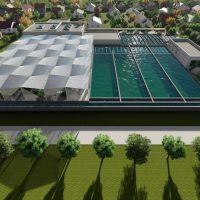Competitive Landscape
Activated Sludge
Activated Sludge (AS) is a 100-year-old technology for biological wastewater treatment. It is the most commonly used biological process for sanitary wastewater treatment on the market today, with 80-90% market share, and therefore it serves as a benchmark for all other solutions. AS systems rely on suspended micro-organisms and bacteria (collectively referred to as biomass) to consume the contaminants in wastewater. The facilities usually include numerous process units spread out over a large physical area and typically are unattractive structures with visible wastewater and foul odors emanating from the facility.
The Organica Food Chain Reactor (FCR) uses the same basic principles as Activated Sludge, but drastically improves the process by leveraging a fixed-bed biofilm that grows on both natural (plant) and engineered (patented biofiber media) root structures in a cascading reactor design, allowing a much greater quantity and diversity of organisms to thrive in the same physical space. The result is a more stable and resilient system that uses up to 60% less space and requires 30% or greater less energy than an Activated Sludge system for the same application. This differentiation is further enhanced by the fact that each Organica FCR plant is housed in a fully-enclosed, odorless, greenhouse facility resulting in infinitely more flexibility in terms of where the wastewater treatment plant (WWTP) can be located, thereby reducing infrastructure costs and eliminating negative impacts on surrounding land value.
Moving Bed Biofilm Reactor (MBBR)
MBBR technology is a type of IFAS system that improves the Activated Sludge process by using a moving-bed biofilm that grows on a large number of plastic carrier discs placed inside the biological reactors, allowing a large quantity of biofilm to thrive in the same physical space. The result is a smaller footprint and reduced construction costs, as well as reduced sludge production. The carriers and some of the biomass are kept in suspension using intensive coarse bubble aeration, which results in a higher energy consumption to maintain the biology when compared to AS. Organica FCR offers the following advantages compared to MBBR:
- Due to the unique structure of the biofilm fixed on the natural (plant) and engineered (patented biofiber media) root structures in an Organica FCR, the oxygen required to keep the biomass biology alive is much lower. In addition, MBBRs require coarse bubble aeration and special mixers to keep the carriers “moving,” whereas in an Organica FCR, we can use fine bubble aeration even in the Anoxic tanks. The result is that Organica FCR requires significantly less energy.
- The quantity and diversity of the biomass in an Organica FCR WWTP is significantly greater than in an MBBR WWTP, resulting in a smaller footprint as well as a more resilient and flexible system.
- MBBRs have experienced significant operational problems due to the propensity of the biofilm carriers to get out of the biological reactors, whereas the operation of an Organica FCR is generally low maintenance as the biofilm is all fixed on the root structures.
Sequence Batch Reactor (SBR)
SBR technology is an optimized version of AS which treats the influent in batches, resulting in greater flexibility and a smaller footprint compared to AS systems. The technology has been around for 50 years and is typically used for smaller-capacity wastewater treatment plants. The Organica FCR solution offers the following advantages compared to SBR:
- All of the biomass in SBR systems is in suspension (e.g. it is not an IFAS system), and thus the quantity of biomass per m3 of reactor space is lower, and the biomass requires a higher level of oxygen to sustain it. The result is that Organica FCR offers significant advantages with a smaller footprint and lower energy consumption.
- The Organica FCR’s cascading reactor design provides a greater number of sequenced reactors (typically 6 compared to 1 or 2 in SBR systems), which – when combined with the fixed-bed biofilm and lower suspended solids content – contributes towards less excess sludge production vs. SBR.
Membrane Bioreactor (MBR)
MBR technology is an Activated Sludge system which leverages membranes for enhanced biomass growth and efficient phase separation. Due to the membranes, MBRs can house a large quantity of biomass – all in suspension – in the same physical space as an AS plant for the same application, resulting in a smaller footprint. The technology has been around for 30 years and is typically used for industrial applications and in situations where a high-quality effluent is required (e.g. reuse). The Organica FCR solution offers the following advantages compared to MBR:
- While MBR offers a small footprint and high-quality effluent, it accomplishes this by having a high level of suspended biomass in the reactors, resulting in highly inefficient oxygen transfer rates. When combined with the air required to prevent membrane fouling, the result is that MBRs typically require up to 2 times more energy that an Organica FCR solution for the same application.
- Organica FCR also offers other advantages including lower capital expenditure (membranes are expensive and more than offset the lower construction costs from smaller footprints) and lower sludge production due to the fact that the vast majority of the biomass in an Organica FCR is fixed on the root structures as opposed to in suspension as in an MBR.

